eISSN: 2576-4462


Research Article Volume 4 Issue 5
Faculty of Agronomy, University of Concepción, Chile
Correspondence: Celerino Quezada, Faculty of Agronomy, University of Concepción, Chile, Tel 56-42-2208927
Received: June 25, 2020 | Published: September 7, 2020
Citation: Quezada C, Merino R, Chandía A, et al. Use of phytomonitoring to evaluate the irrigation scheduling in vineyards (vitis vinifera l.) of itata valley Chile. Horticult Int J. 2020;4(5):169?172. DOI: 10.15406/hij.2020.04.00177
The phytomonitoring is a technology that provides information in real time of crop water status and allow to make a feedback between crop and grower to improve the irrigation control. The aim of this investigation was to asses the plant water status and your effect on yield and quality parameter in a commercial vineyard under drip irrigation in an Ultic Palexeralf soil during the 2008-2009 growing season at Central Southern of the Ñuble Region, Itata Valley, Chile. The experimental design was split-plot with three treatments of soil texture: clayey loam, sandy clay and clayey, and three sub-treatments of ‘Cabernet Sauvignon’, ‘Merlot’ and ‘Syrah’ cultivars. Stomatal conductance, leaf-air temperature, cluster weight, berry diameter, berry weight, and soluble solids content were evaluated. The results showed that the phytomonitoring is useful to evaluate the irrigation management in vineyards. Stomatal conductance and leaf-air temperature showed good performance as indicators of vine water status and grapevine quality. This study highlight the effect of soil texture on yield and wine quality in grapevines of semi-arid zones with drip irrigation.
Keywords: stomatal conductance, leaf temperature, soil texture, yield components
Different instruments measure various aspects of soil-water relations, but none direct assesses the portion available water to the vine. Thus, they do not provide an accurate map of the spatial and temporal variability in moisture troughout the vineyard and such variation can significantly affects vine growth and irrigation efficiency.1 Nowdays, the phytomonitoring technique allow the adquisition of a big pool of soil-plant -water data in real time, making possible a more precise estimation of vineyard water fluxes.
Phytomonitoring is a management information system for crop growing and has three main functions: generate a customized sets of measured values and their derivatives used by a grower in daily control productive, early detection of unexpected disorders in plants and decision support-system.2
This system include the moisture measurements and the development of an intelligent control system, in order to maintain the moisture level around level set, such as water stress or field capacity, according to the desired enological grape quality, in addition helps to overcome difficulties imposed by a growing water demand.3 The use of physiological parameters to asses the dynamics of plant water status has attracted the attention of many growers. This technique relates teh soil physical properties and the environmental conditions within the orchard with its effects on plant growth.
Plants express physiological responses to dynamic balance changes in the soil-plant water-environmental system and the phytomonitoring measure the plant water status, integrating the soil water availability with the air vapour pressure deficit, decreasing the effect of soil spatial variability in the management of frecuency and timing irrigation.4 This technique combines data acquisition system based on specific sensors and data processing software, which presents measuring information in terms of plant physiology and agronomy5 and has demostrated great potential for assessing vine water status.6
Water status parameters such midday stem water potential (Ψs), stomatal conductance (gs) and leaf-air temperature (dT) have been used to improve the irrigation management for vineyard in arid areas.7 The infrared thermometry can be used for the irrigation scheduling of the grapevine.8 However, the variable responses of different cultivars to different climatic conditions and water stress levels make it difficult to use only one indicator for vine water status or irrigation scheduling.9 According to Cifre et al.7 gs is a more precise and sensitive indicator of water stress than Ψs and relative water content (RWC), when mild or moderate soil water deficit is applied.
Stomatal closure is known to be a sensitive response to soil water deficit and can be used to determine the water status of plants. Direct estimation of leaf stomatal conductance to water vapor from temperature measurements, avoids the need for multiple and time consuming leaf gas-exchange measurements and allows for assessment of variation in stomatal conductance over large crop area.10
The aim of this investigation was to asses the use of stomatal conductance and leaf-air temperature on the irrigation scheduling of three grapevine cultivar under drip irrigation in an Ultic Palexeralfs at Central Southern of the Ñuble Region, Itata Valley of Chile
Site experimental
A field experiment was carried out in a commercial vineyard planted in 2004 at central-southern Chile (36° 36’ S, 71° 55’ W,) Ñuble Region, Itata Valley, in an Ultic Palexeralfs soil, during 2008-2009 growing season. The climate is Mediterranean with average annual rainfall is 1100 mm. Annual reference evapotranspiration is reported as 1200 mm, with a dry period of 4 to 5 months and with 5-6 frost-free months. Average annual mean temperature for this area is 13.5°C with an average temperature of 3.7°C in the coldest month (June) and 28°C in the hottest month (January). Annual mean relative humidity is 70%.11
Vineyards
The commercial vineyard (Figure 1) has a area of 50 ha divided in 13 drip irrigation sectors. The cultivars ´Cabernet Sauvignon´, ‘Merlot` and ‘Syrah` was planted at 3 m between rows and 0.8 m between plants, trained by modificated Scott Henry system. The vines were irrigated by drip irrigation (one emitter per vine at 4 Lh -1 and 10 w.c,m.). The timing varied from 1 to 4 hours and the irrigation frecuency of 1 to 2 days. The applied water volume during the growing season were 1640 m3 ha-1 in clayey loam, 1987 m3 ha-1 in sandy clay and 1261 m3 ha-1 in clayey soil.
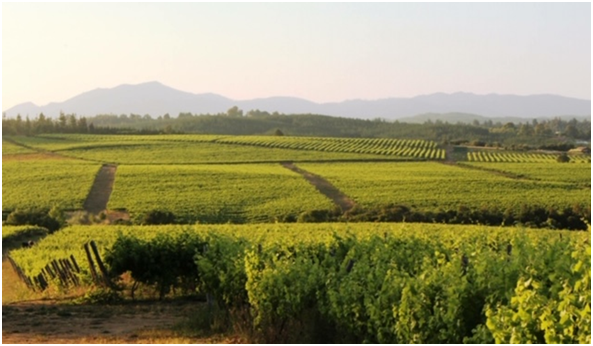
Figure 1 Vineyards santa cruz de bellavista farm, riveras del valle wines, Itata valley, Ñuble region, Chile.
Experimental design
The experimental design was a split-plot with three treatments of soil texture (clayey loam, sandy clay and clayey), three sub-treatments: ´Merlot´,´ Cabernet Sauvignon´ and ´Syrah´ cultivars, and three replicates of 10 vines.
Evaluations
Stomatal conductance (gs) and leaf-air temperature (dT) was measured every 15 days between 11:00 and 16:00 hr using a diffusion porometer (Delta-T AP4 Devices, Cambridge, UK) in 6 leaf per vine. At harvest, cluster weight, berry diameter and berry weight in 4 clusters per vine were measured. The equatorial diameter of 100 berry per cluster by calibrator 15-28 mm ( Field Instruments, Santiago, Chile) and soluble solid concentration using a thermo-compensated retract to meter 0-32º Brix (Atago N-4e,Atago Co. Ltd., Atago, Japan) were measured.
Statistical Analysis
Data analysis was done by ANOVA. The comparison of treatments mean was made by the Duncan´s test at 5% probability. Normality was contrasted with the Shapiro-Wilks modified.12
The gas exchange plant-atmosphere was similar during the growing season, that gs values in January were of 172 and 175 mmol m-2 s-1 in clayey loam and clayey soil, respectively and 179 mmol m-2 s-1 in sandy clay soil (Figure 2). However, November showed greater values of gs in three soil textures due to low crop evapotranspiration (24 mm) as compared with critical month (113 mm). An optimum threshold for gs ranged between 50 and 150 mmol m−2 s−1 is adequate to increase water use efficiency in grapevines.12
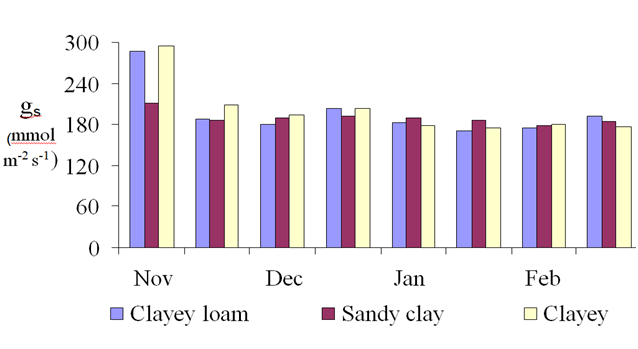
Figure 2 Stomatal conductance (gs) in grapevine with drip irrigation in three soil texture of an Ultic Palexeralfs during the growing season.
Regarding soil texture, the lower gs was found in sandy clay (193 mmol m-2 s-1 ) that indicate a mild water stress in comparison with clayey loam (208 mmol m-2 s-1) and clayey soil (205 mmol m-2 s-1) (Figure 3), probably because the applied water volume was lower (1987 m3 ha-1) that the vine water requirements . Besides, the sandy soils have lower water-holding capacity that decreased the leaf gas exchange.13
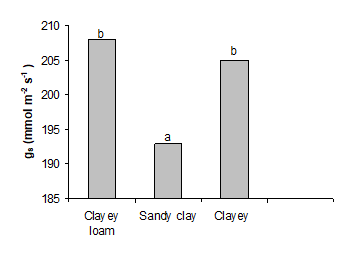
Figure 3 Stomatal conductance (gs) in grapevine with drip irrigation in three soil texture of an Ultic Palexeralfs. Differents letters on each column indicate significant differences at p ≤0.05) according Duncan’s test.
Regarding cultivars ´Cabernet Sauvignon´, ‘Merlot’ and ‘Syrah’ showed significative differences (p<0.05) of gs in three soil texture (Figure 4) indicating a differential response to edapho-climatic conditions and the applied water volume, that will be associated with the stomatal performance14 and drought-resistant cultivar.15 Consequently, ‘Merlot’ had the best performance in clayey due to greater water availability (11,25%), but for Cabernet Sauvignon and Syrah was obtained in sandy clay texture due to anisohydric stomatal behavior.16 However, Levin et al.17 showed that V. vinifera cultivars possess both iso- and anisohydric stomatal behaviours that depend on the intensity of water deficits, and call into question previous classifications assuming a single behaviour.

Figure 4 Stomatal conductance (gs) in grapevine ‘Cabernet-Sauvignon’, ‘Merlot’ y ‘Syrah’ with drip irrigation in three soil texture of an Ultic Palexeralfs. Differents letters on each column indicate significant differences at p ≤0.05) according Duncan’s test.
These results remarks the effect of soil texture and cultivars in the stomatal conductance with values between 150 -250 mmol m-2 s -1 that is in accordance with Medrano et al.14 who showed values between 60 and 200 mmol H2O m -2 s -1 , which would correspond to severe when drops below 50 mmol H 2O m-2s-1, moderate between 50 and 150 mmol H 2O m -2s -1 and mild typically 200–500 mmol H2O m-2 s-1 in grapevines water stress.14,18 The thresold level in grapevines would be 200 mmol m -2 s -1 for mild stress in the three types of soil, but Cabernet , Sauvignoin and Syrah it have a better adaptation on sandy clay and Merlot on clayey soil (Figure 4). This is in ccordance with Quezada et al.19 who remarked the influence of soil physical properties in the selection of sites with viticultural aptitude incuding cultivars.
Regarding leaf-air dT (ºC), the vines showed positive values in December and January about 1,4º C in the sandy clay (Figure 5) indicating temporary and mild water stress due to lower water-holding capacity of the soil.13
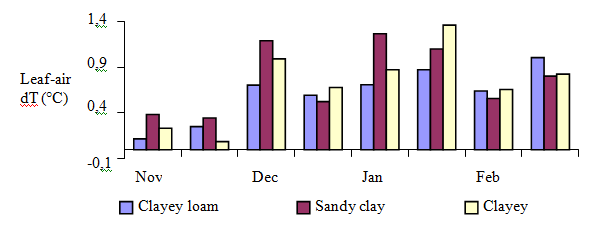
Figure 5 Leaf-air dT (ºC) in grapevine with drip irrigation in three soil texture of an Ultic Palexeralfs during the growing season.
The effect of soil texture was significative (p≤0,05) on the leaf-air dT (Figure 6) with positive values in sandy clay (0,8 °C) that indicating mild water stress in comparison with vines planted in clayey loam and clayey soil. This is in accordance with the results of gs ,due to lower water availability of sandy clay (7,0%) as compared with clayey loam (8,4%) and clayey soil (11,25%). According to Ubalde et al.20 the soil properties related to soil moisture regime have a direct influence on vineyard management and grape quality.
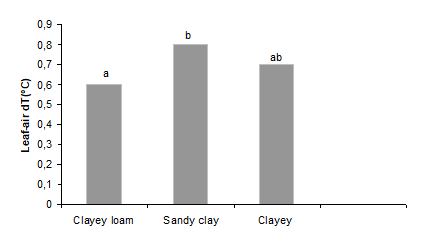
Figure 6 Leaf-air dT (ºC) in grapevine with drip irrigation in three soil texture of an Ultic Palexeralfs soil. Differents letters on each column indicate significant differences at p ≤0.05) according Duncan’s test.
The cultivars, ‘Merlot’ and ‘Syrah” showed higher leaf–air dT in sandy clay soil due to lower soil water availability, but in Cabernet Sauvignon dT was lower in clayey loam (Figure 7) .In general, the cultivars revealed the best response to irrigation management in clayey loam texture, that the leaf-air dT was 0.6°C probably due to greater wetted soil volume. However, the higher leaf-air dT was found in sandy clay texture, that indicate mild water stress and the need of improve the irrigation scheduling.
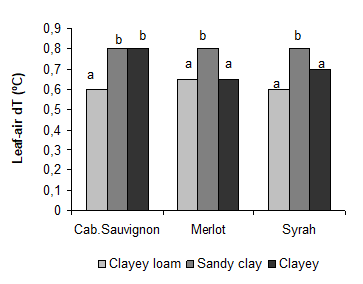
Figure 7 Leaf-air dT (ºC) in grapevine ‘Cabernet Sauvignon’, ‘Merlot’ y ‘Syrah’ with drip irrigation in three soil texture of an Ultic Palexeralfs. Differents letters on each column indicate significant differences at p ≤0.05 according Duncan’s test.
Concerning yields components, cluster weight showed significant differences with the soil texture (p<0.05) only for ‘Cabernet Sauvignon’ (Table 1), showed lower values in sandy clay texture, due to the minor number of berries per cluster and low water availability (7%). Respect to berry weight, only ‘Cabernet Sauvignon’ not showed significant effects, but in berry diameter the soil texture had significant effect on the three cultivars.
Soil texture |
Cluster weight |
Berry weight |
Berry diameter |
Soluble solids |
|
CS ME SY |
CS ME SY |
CS ME SY |
CS ME SY |
Clayey loam |
98,8 b 92,4a 91,5 a |
1,1a 1,2 b 1,1ab |
12,5b 12,6b 12,9ab |
26,0ab 23,6a 25,2a |
Sandy clay |
82,5 a 107,0 a 76,8 a |
1,1a 1,0 b 1,2 b |
12,2a 12,4a 13,1 b |
27,0b 25,6c 24,4a |
Clayey |
97,6 b 105,7 a 79,8 a |
1,1a 1,1ab 1,0 a |
12,2a 12,4a 12,8a |
24,9a 24,7b 24,3a |
Table 1 Yield components and quality of grapevine ‘Cabernet Sauvignon’, ‘Merlot’ and ‘Syrah’ with drip irrigation in three soil texture of an Ultic Palexeralfs. Differents letters in the same column indicate significant differences at p≤0.05 according Duncan’s test
CS, cabernet sauvignon; ME, merlot; SY, syrah
The soil texture had significant effects (p<0,05) in the wine quality of ‘Merlot’ and ‘Cabernet Sauvignon’ with maximum ºBrix in sandy clay soil (Table 1) due to the effect of water stress in advanced fruit maturation.21 On the other hand, ‘Syrah’ not showed significant differences in ºBrix with the soil texture, according with results obtained by Reynolds et al.16 with different irrigation regimes.22
The results showed that the phyto monitoring is useful to evaluate the irrigation managementin vine yards. Stomatal conductance and leaf-air temperature diferencial showed good performance as indicators of vine water status and berry quality. This study highlight the influence of soil texture on yield and wine quality in grapevines of mediterranean areas irrigated by drip irrigation. The stomatal conductance thresh. old determined in this investigation was 200mmol m-2 s-1 as indicator of good scheduling irrigation.
None.
Authors declare no conflict of interest exists.

©2020 Quezada, et al. This is an open access article distributed under the terms of the, which permits unrestricted use, distribution, and build upon your work non-commercially.